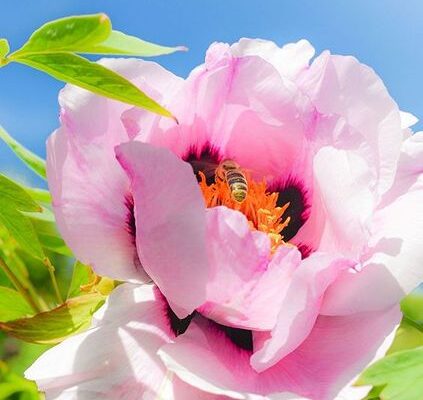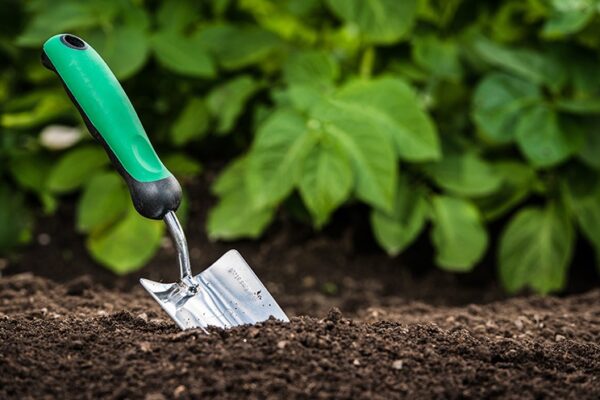The Most Powerful Climbing Roses to Grow
There are various ways in which roses can be grown, depending on personal preference. These beautiful flowers can be pruned to form shrubs or trees, planted in containers, or left to grow wild in any manner that enhances their exquisite appearance and heavenly fragrance. Some rose enthusiasts prefer a neat, well-manicured rose garden, while others prefer the natural, unstructured look of climbing roses.
Climbing roses can be trained to grow up and over a variety of structures such as gazebos, trellises, arbors, fences, and walls. This not only adds a touch of elegance to otherwise plain wooden, metal or stone structures, but also provides a stunning focal point wherever they are planted. The colorful flowers and intoxicating fragrance of climbing roses are sure to captivate your senses.
If you are looking for climbing roses that offer both stunning looks and a delightful aroma, here are 10 recommendations for you to consider.
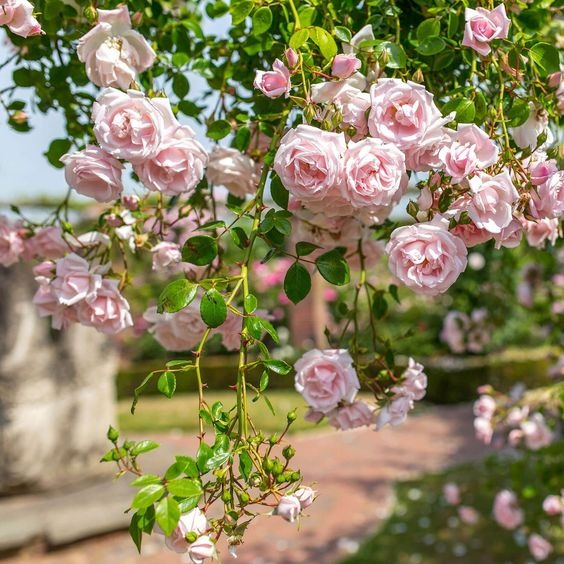
Altissimo
Altissimo is a stunning floribunda rose that produces clusters of small buds that bloom into exquisite single flowers with velvety, bright red petals and a striking central cluster of yellow stamens. The rose’s glossy green leaves also contribute to its overall beauty.
Altissimo is a versatile plant that can be trained to grow as a small climbing rose or a pillar climber. Alternatively, it can be pruned to form a tall shrub. At maturity, the rose typically reaches a height of 7 to 20 feet and a width of 5 to 8 feet.
To ensure the best blooms, it is recommended to feed the rose twice a year – once in the spring and once in the summer. Additionally, pruning should be done just once, in the winter.
Altissimo is well-suited for USDA Growing Zones 5 to 10 and requires full sun exposure. The soil should be well-drained, but the specific type of soil is not critical for this rose’s growth and health.
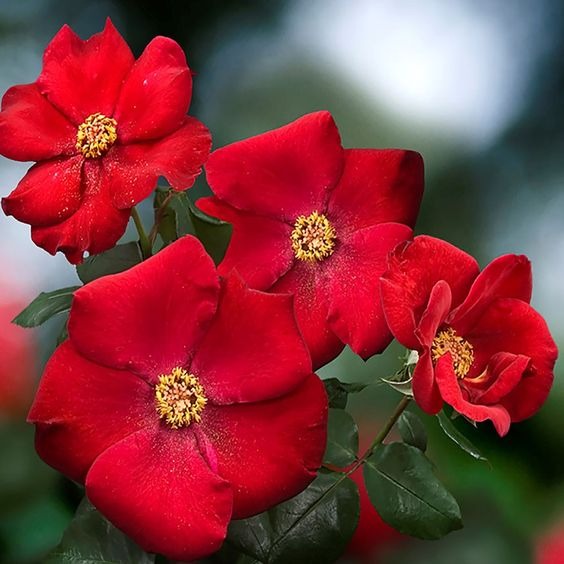
American Beauty
American Beauty is a beautiful and resilient rose variety with deep, cupped dark pink flowers that are tolerant of shade. This hybrid tea rose has long canes, making it ideal for training up walls or trellises. When fully grown, American Beauty can reach a height of 12 to 15 feet.
To maintain the health and vigor of the plant, pruning should be done in the spring to remove dead wood and prevent crossing canes. Healthy canes should be shortened by about one-third of their overall length, and even more if you live in a colder climate.
American Beauty is well-suited for USDA Growing Zones 5b to 9b and requires full sun exposure, although it can tolerate some shade. The soil should be well-drained, moderately moist, and sandy to loamy in texture.

Bridge of Sighs
Bridge of Sighs, also known as Harglowing, is a medium-sized climbing rose that reaches a height and spread of about 10ft. It has a USDA hardiness rating of 7b/8a, making it a good choice for gardeners in regions with mild winters. This rose has beautiful peach flowers with orange buds and semi-double petals that are scallop-edged. The flowers contrast well with the coppery foliage that turns green with age. Bridge of Sighs is a repeat-flowering climber that blooms from summer to fall, and the golden stamens within the flowers attract plenty of insects. This rose is an excellent choice for a rose garden designed around shades of apricot, peach, and coral. It also tolerates partial shade and can be grown against a north-facing wall or fence.
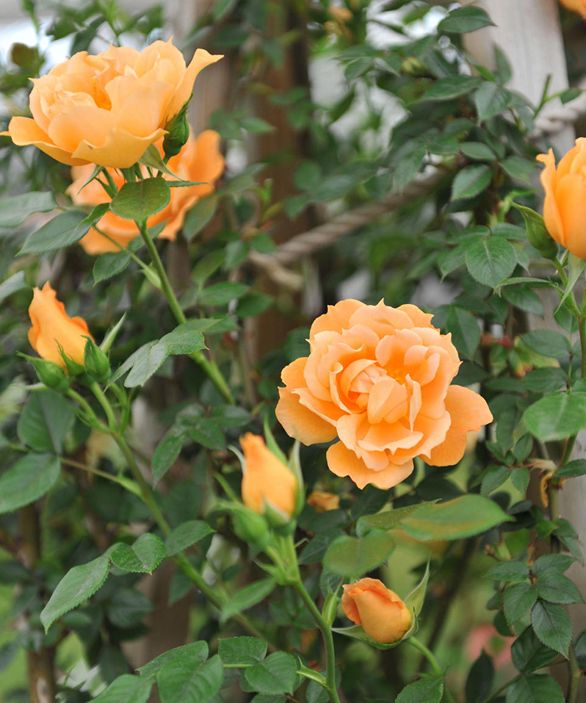
Cecile Brunner
Cecile Brunner is a stunning hybrid tea rose that grows vigorously as a climbing rose, often reaching heights of up to 20 feet and spreading out to 6 feet in width. The rose produces petite clusters of beautiful blush-pink flowers with a delightful sweet, spicy, tea-like fragrance from its beautifully shaped buds.
This romantic rose plant blooms just once, typically in late spring or early summer, and requires only a single feeding in spring. It can tolerate some shade and can thrive in north-facing sites.
Cecile Brunner is best suited for USDA Growing Zones 6 to 10 and requires full sun exposure for optimal growth and bloom. The soil should be rich, well-drained, and evenly moist to support the growth and health of the rose.
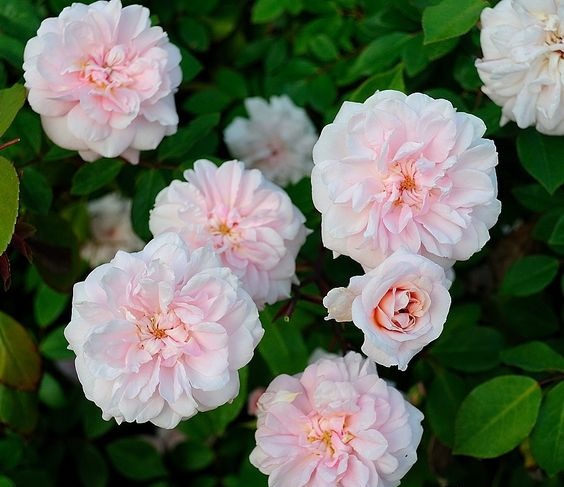
Chawton Cottage
Chawton Cottage is a climbing rose that is perfect for those who want to add a touch of delicate beauty to their cottage garden. This rose has a height and spread of 8 feet, making it a medium-sized climber that can be trained to grow up a wall or trellis. Its hardiness is USDA 6b/7a, meaning it can withstand cold temperatures down to -5°F.
One of the most striking features of Chawton Cottage is its pink and red flowers, which contrast beautifully with its dark green foliage. The flowers are large, semi-double to double bloom in size, and have a sweet scent. They bloom profusely throughout the summer and fall, making it a great choice for those who want continuous color in their garden.
Chawton Cottage is a relatively low-maintenance rose that can be grown in full sun or partial shade. It prefers well-drained soil and should be watered regularly, especially during dry periods. It can also benefit from some pruning in late winter to encourage healthy growth and shape the plant.
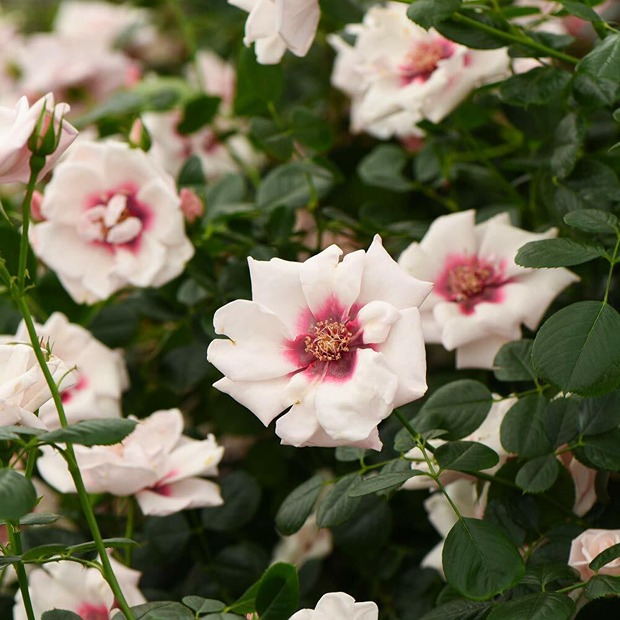
Dublin Bay
Dublin Bay is a floribunda climbing rose that thrives in full sun and produces medium to large-sized rich, velvety red flowers with dark, glossy green leaves. The flowers have a mild, fruity perfume that adds to the rose’s allure. When mature, Dublin Bay can grow 8 to 12 feet tall and up to 5 feet wide.
One of the unique features of Dublin Bay is its ability to bloom for an extended period, often throughout the growing season. To ensure optimal blooming, it’s recommended to plant this climbing rose in a location that receives at least 6 hours of direct sunlight per day.
Dublin Bay is best suited for USDA Growing Zones 6b to 9b and requires well-drained, moist soil that ranges from sandy to clay. Adequate soil drainage and moisture are essential for the growth and health of this beautiful rose.
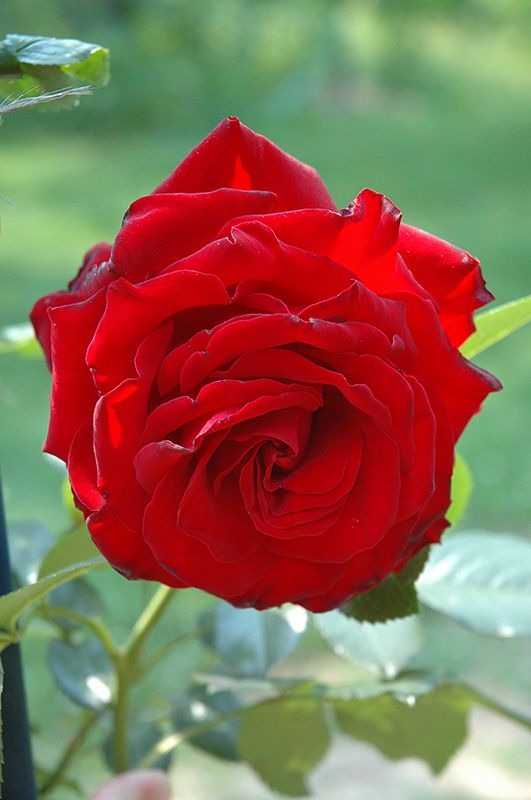
Fourth of July
Fourth of July is a large-flowered climbing rose that boasts profuse clusters of red-and-white-striped, semi-double blooms with a sweet fragrance reminiscent of freshly cut apples. This repeat bloomer can grow up to 12 to 14 feet tall and 3 to 6 feet wide, making it a stunning addition to any garden.
This woody vine is known for its resilience to urban pollution and can live for decades with proper care. For optimal growth and resistance to disease, it’s recommended to plant Fourth of July in full sun.
This climbing rose thrives in USDA Growing Zones 6a to 9b and requires well-drained, slightly acidic loamy soil. Ensuring the soil is well-draining and slightly acidic will provide the necessary nutrients for Fourth of July to thrive and produce its beautiful blooms.
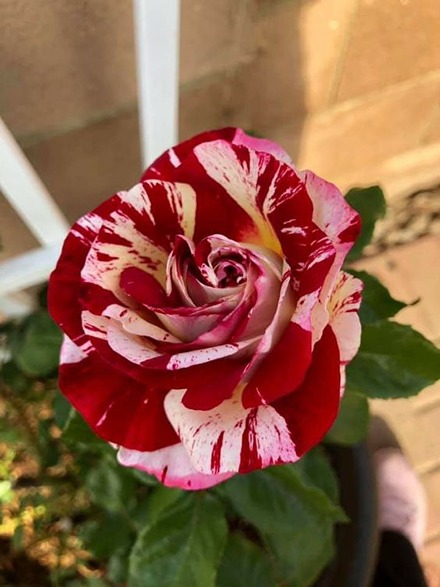
Golden Gate (Korgolgat)
Golden Gate is a relatively new modern climber introduced in 2005 and is among the best climbing plants to grow in a garden. While Golden Showers has been a popular choice since the 1950s, Golden Gate is a more compact, disease-resistant, and free-flowering variety. It can reach a height of 8 feet with a spread of 6 feet and is hardy in USDA zones 6b/7a. Its fragrant, semi-double blooms are a bright medium yellow color, making it a cheery addition to any garden. These flowers bloom throughout the summer and fall and are followed by hips if the last blooms are not deadheaded.
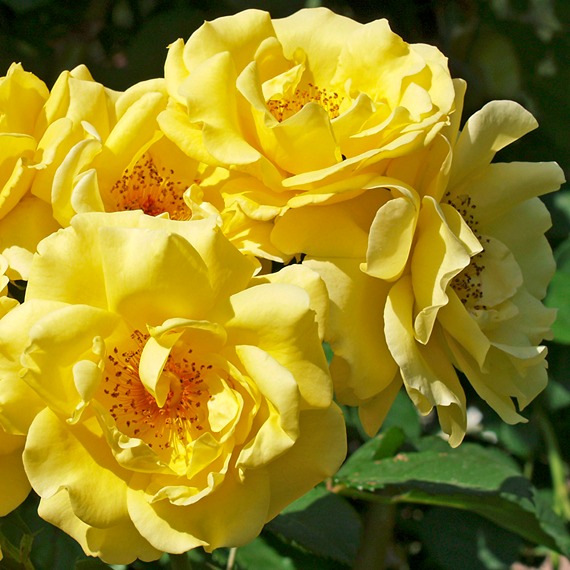
Iceberg
Iceberg is a floribunda climbing rose that is often considered the best in its class. It grows up to 15 feet tall and has large, ruffled, and abundant blooms that repeat throughout the season. While its flowers are beautiful, they are also fragrance-free, which is a drawback for some.
One issue to be aware of when growing Iceberg is black spot, a common fungal disease that can occur in high humidity with poor air circulation. It is crucial to maintain good airflow around the plant to prevent this disease.
This climbing rose can thrive in USDA growing zones 4b to 9b and requires full sun exposure. The soil should be well-drained and moist to support the plant’s growth.
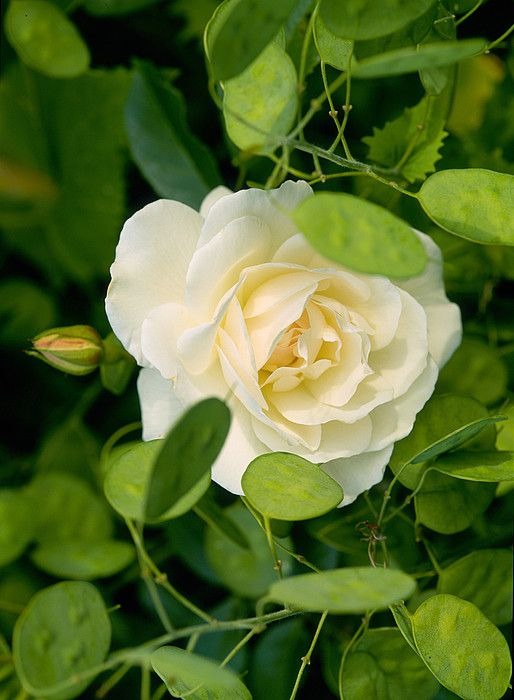
Peace
The Peace rose is considered to be the most extensively cultivated rose worldwide. Its canes can grow over 20 feet, which makes it an ideal climbing rose. It is often used to adorn fences or large walls due to its prolific, ruffled, yellow-and-pink, extra-large blooms, which can be as large as 6 inches across. This rose is a hybrid tea type and has a fruity fragrance.
One of the reasons why ‘Peace’ roses are so popular is because of their versatility. They can be grown in containers, hedges, borders, beds, and mass plantings, making them suitable for a wide range of gardening applications. The Peace rose thrives in full sun, and requires medium moisture, well-drained, and slightly acidic soil. It is suitable for USDA Growing Zones 6b to 9b.
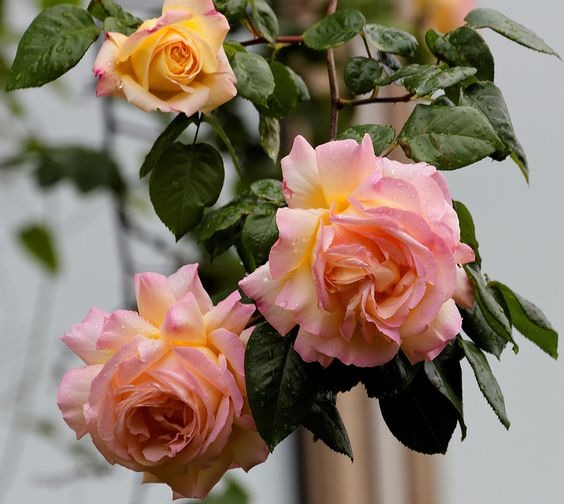
Royal Sunset
Royal Sunset is a hybrid tea rose that has a stiff cane that can climb and spread up to 10 feet. It is a repeat bloomer and produces beautiful bouquets of large, shapely, apricot-colored blooms with a strong fruity fragrance. The plant also has dark, bronzy-green, glossy leaves that provide an attractive background for its flowers.
To ensure the plant produces the most blooms, pruning should be done in late winter while the plant is still dormant. Deadheading should be done throughout the growing season but stopped in late summer to avoid new growth that could be damaged by frost. Royal Sunset grows best in full sun and loamy, well-drained soil. It is suitable for USDA growing zones 6 to 10.
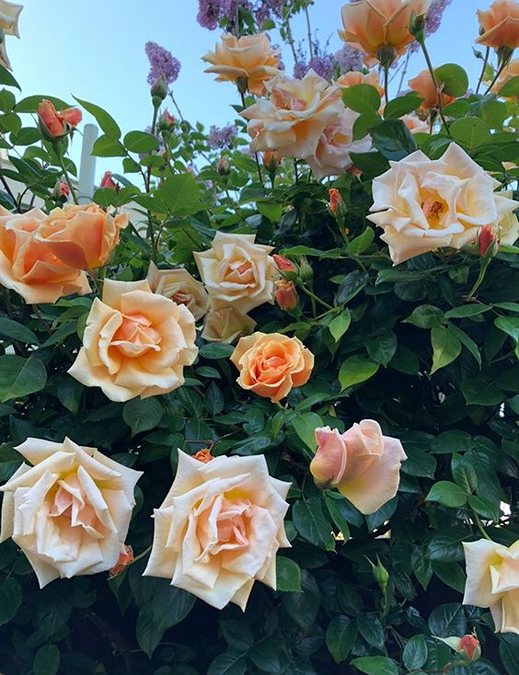
Souvenir de la Malmaison
Souvenir de la Malmaison is a climber rose that originated from the old bourbon rose. This rose plant is known for its vigorous growth and can have canes that reach up to 20 feet tall and 8 feet wide. Its flowers are extremely fragrant and have a pale pink color with full-petaled and quartered blooms.
However, it’s worth noting that the flowers of this rose are best enjoyed on the plant, as they don’t make the best cut flowers. To grow Souvenir de la Malmaison, it requires moist, fertile, and well-drained soil, as well as full sun to part shade exposure.
This rose plant is recommended for USDA growing zones 5b to 10b, which means that it can survive in regions with cold winter temperatures as low as -15°F (-26°C) and warm summer temperatures as high as 40°F (38°C).
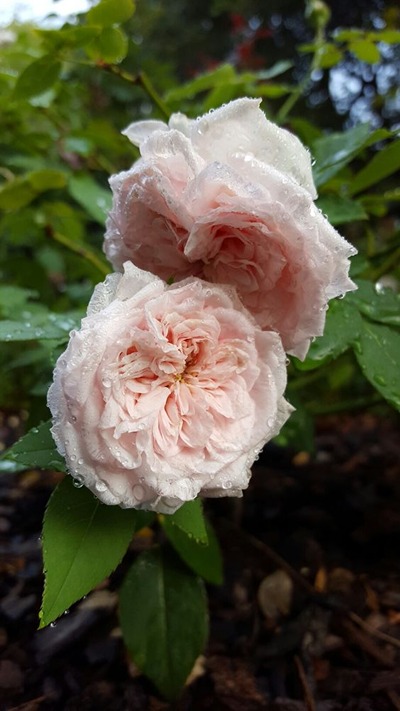
Westerland
Westerland is a versatile rose that can be used as a shrub or a climber. This winter-hardy plant produces large, copper-orange to apricot colored flowers with a strong and spicy fragrance. It can grow up to 5 to 12 feet in height and 4 feet in width. To protect it from the wind, light pruning can be done in late fall or early winter, while any significant pruning should be saved for springtime.
Westerland requires full sun exposure and moderately fertile, well-drained, and moist soil. This plant thrives in USDA Growing Zones 5b to 9b. With its stunning blossoms and delightful scent, Westerland makes a beautiful addition to any garden.

Difference between a standard rose and a climbing rose?
The distinction between a rose and a climbing rose lies in their growth habit and flowering pattern. While both are members of the same plant family and produce beautiful, fragrant flowers, rambling roses typically bloom only once per season, while climbing roses typically bloom multiple times throughout the summer and autumn months. However, there are exceptions to this rule, and some rambling roses may bloom multiple times, while some climbing roses may only bloom once.
The key difference between the two is that rambling roses tend to grow in a wilder, uncontrolled manner; producing long, arching branches that can reach up to 20 feet in length, while climbing roses are more trainable and produce stiff, upright stems that can be trained to grow up a trellis, wall, or other structure. Ultimately, the choice between a rose and a climbing rose will depend on the gardener’s desired growth habit and flowering pattern.
